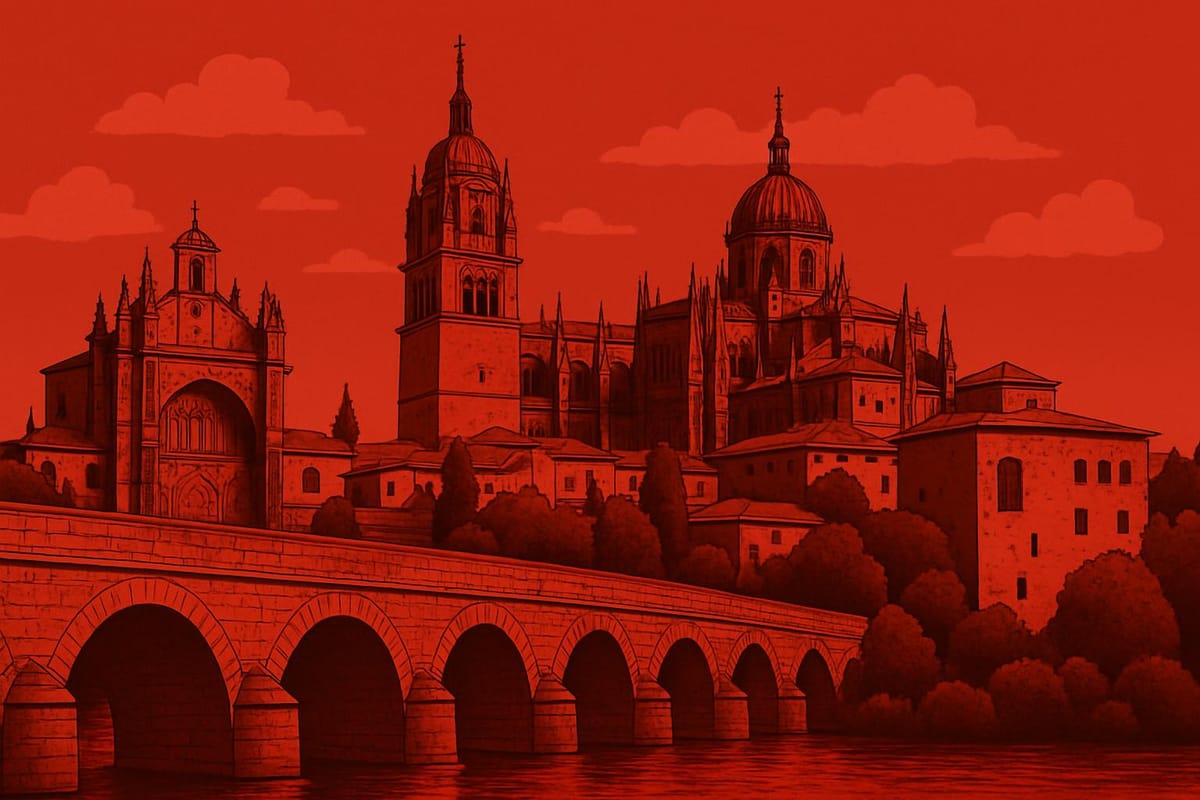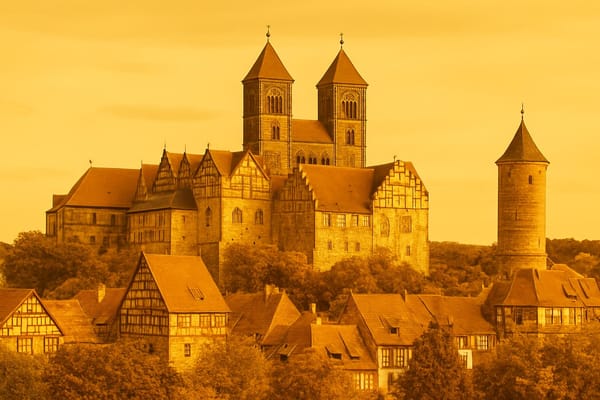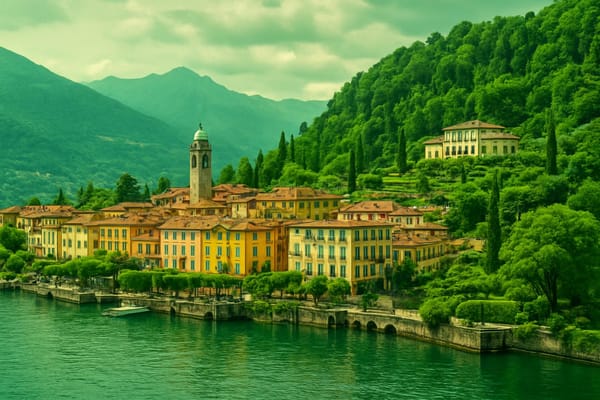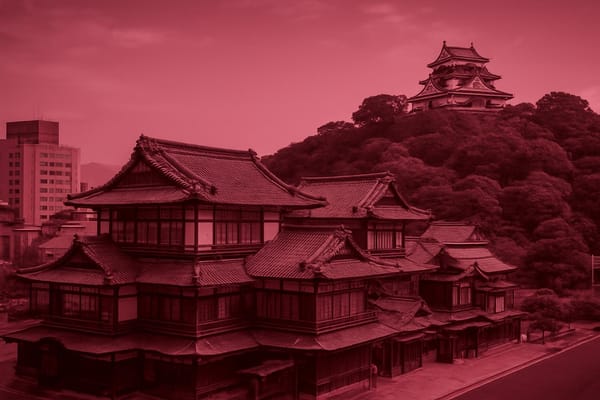Salamanca
Discover a UNESCO old town: historic university, golden sandstone, Plaza Mayor & tapas.

Important things to know about Salamanca
Salamanca, Spain, is a vibrant city where centuries of history and contemporary life mingle in a compact urban fabric, creating an atmosphere prized by students, scholars and visitors drawn to its lively streets; known for its prestigious university heritage, Salamanca combines academic intensity with a spirited student life that fuels cafes, bookstores and cultural venues, while local markets and restaurants showcase a rich gastronomy rooted in Castilian tradition. The built environment is marked by warm sandstone façades and a variety of architectural styles that reflect long cultural continuity, giving the city a distinctive visual identity that resonates through its residential neighborhoods and public spaces. Economically, Salamanca balances higher education and research with small businesses, services and a growing creative sector, making it a regional hub in Castile and León where language schools, cultural institutions and technology initiatives intersect. Everyday life in Salamanca is characterized by a strong sense of community, seasonal rhythms, and a walkable scale that encourages social interaction; the city’s compactness supports sustainable mobility and a mix of housing types that accommodate both long-term residents and a transient academic population. With multilingual outreach and international academic connections, Salamanca plays an important role in Spain’s cultural diplomacy and educational exchange, while local traditions, crafts and culinary offerings continue to evolve alongside modern amenities, ensuring the city remains both historically resonant and forward-looking.
Sightseeing hot-spots in Salamanca
Salamanca is a compact city in Spain whose golden-hued stone and lively plazas make it a must for travelers seeking rich historic atmosphere and remarkable architecture. At the heart of the city, the Plaza Mayor buzzes with cafés and street life, an elegant 18th-century square that serves as the social and visual centerpiece for sightseeing in Salamanca. Strolling from the square, visitors encounter the University of Salamanca, one of Europe's oldest universities, whose ornate façade and cloisters invite admiration and reflection on the city’s scholarly legacy. The university’s famous salamander carving is a small but popular icon for tourists photographing the façade and exploring nearby narrow streets.
Religious architecture is a major highlight, with the adjoining Old Cathedral and New Cathedral forming a dramatic skyline of spires and flying buttresses. The Old Cathedral’s Romanesque and Gothic elements contrast beautifully with the New Cathedral’s later, more intricate Gothic and Baroque additions, offering a layered narrative of centuries of Spanish church design. For those interested in palatial residences and unique façades, the Casa de las Conchas-decorated with hundreds of scallop shell motifs-is a striking example, while the art nouveau Casa Lis houses a impressive collection of decorative arts inside a glass-fronted mansion.
Beyond monuments, Salamanca rewards slow exploration: cross the historic Roman Bridge to enjoy riverside views, savor the city’s culinary scene in intimate taverns, and lose yourself in the warm glow of its sandstone at dusk. As a UNESCO World Heritage site, Salamanca combines scholarly heritage, monumental churches, and vibrant urban life, making the city a top destination for anyone compiling things to do in Salamanca or planning unforgettable sightseeing in Spain.
Hotels to enjoy in Salamanca
Salamanca, Spain, attracts travelers with its golden sandstone architecture and vibrant student life, and the hotels in Salamanca reflect that unique blend of history and hospitality. Stays range from elegant boutique properties tucked into renovated 16th-century buildings near the Plaza Mayor to modern luxury hotels offering terraces with panoramic views of the Cathedral. Many Salamanca hotels sit within walking distance of the historic center, so guests can easily explore the University of Salamanca, medieval streets, and lively tapas bars. Whether you search for family-run guesthouses that emphasize local charm or contemporary chains with fitness centers and free Wi‑Fi, the city’s accommodation options meet diverse needs and budgets. Reviews often praise the combination of location, character, and friendly service that make Salamanca hotels ideal for weekend getaways, cultural trips, and academic visits.
When choosing among Salamanca hotels, consider what matters most: proximity to attractions, traditional décor, or modern conveniences like on-site parking and air conditioning during hot summers. Early booking can secure rooms in some of the best hotels in Salamanca, especially during Holy Week and university events when demand rises. Travelers who prefer quieter streets might opt for lodgings near the River Tormes, while those who want nightlife and dining at their doorstep should prioritize the area around Plaza Mayor. Clear photos, recent guest reviews, and flexible cancellation policies help identify accommodations that combine value and authenticity. In short, Salamanca offers an array of lodging that captures the city’s historic spirit while providing contemporary comforts, ensuring visitors find the right hotel for a memorable stay.
Restaurants to try in Salamanca
Salamanca’s dining scene blends centuries of tradition with lively student-town energy, making restaurants Salamanca a compelling draw for food lovers. In the shadow of the golden sandstone façades and the buzzing Plaza Mayor, you’ll find a mix of cozy tapas bars, family-run taverns and contemporary eateries where classic Castilian flavors shine. Signature dishes such as jamón ibérico, hornazo, cocido castellano and generous chuletón steaks are complemented by local wines from the nearby Ribera del Duero and Toro regions. The city’s markets and small producers supply fresh produce and cheeses, so each meal often tastes rooted in place. Whether you prefer a leisurely multi-course dinner or an evening of hopping from bar to bar sampling tapas Salamanca style, the atmosphere - warm service, lively conversation and the echo of centuries-old streets - makes dining here as much an experience as the food itself.
At the same time, Salamanca’s culinary landscape is evolving: creative chefs are putting modern spins on traditional recipes and offering tasting menus that spotlight seasonal, farm-to-table ingredients. You’ll find options to suit every palate, including vegetarian and plant-forward plates, intimate wine-pairing dinners and bustling counters where pintxos are served with a contemporary twist. For visitors seeking the best restaurants Salamanca has to offer, a little research and local recommendations will reveal both hidden gems and well-loved institutions. Reservations are wise for weekend evenings, and walking the historic center often leads to the most memorable meals - a perfect blend of historic charm and gastronomic innovation.
Best shopping stops in Salamanca
Salamanca’s shopping scene is as historic and vibrant as its golden sandstone architecture, making shopping in Salamanca a must for visitors who want more than just sightseeing. Wandering from the iconic Plaza Mayor down the bustling Calle Toro, you’ll find a lively mix of fashion boutiques, high-street brands and independent boutiques that showcase both contemporary Spanish design and timeless classics. The compact old town concentrates most stores within picturesque streets, so Salamanca shopping easily pairs with a café stop or a stroll past university facades. Shoppers looking for unique wardrobe pieces, local designer labels or classic Spanish footwear will appreciate the balance of modern retail and artisan ateliers that give Salamanca a distinctive retail identity.
For foodies and collectors, Salamanca’s markets and specialty shops are highlights of any shopping trip. The historic Mercado Central and narrow lanes nearby are overflowing with gourmet Spanish produce, from Iberian ham and artisan cheeses to carefully selected regional wines and olive oils, perfect as Spanish souvenirs. Equally rewarding are the stores selling local crafts, hand-painted ceramics and leather goods-items that reflect the region’s heritage and make meaningful gifts. Antiquarians and lovers of decorative objects will find charming antiques and vintage stores tucked away, while seasonal markets bring pop-up stalls full of jewelry, textiles and handmade trinkets. Whether you’re hunting for culinary delights, designer fashion or authentic artisanal souvenirs, shopping in Salamanca offers variety, quality and a memorable cultural backdrop that enhances every purchase.
Nightlife highlights in Salamanca
Salamanca, Spain, comes alive at dusk as the Plaza Mayor glows under golden lights and crowds gather for the quintessential Spanish aperitivo. The city’s nightlife highlights range from cozy tapas bars tucked down medieval streets to lively terraces where students and locals mingle over cocktails and cerveza. For those seeking live entertainment, intimate venues offer live music and flamenco nights, while historic bars serve up traditional plates alongside contemporary fusion, making every evening a culinary discovery. The compact layout of the old town means you can wander between centuries-old architecture and modern hotspots, soaking in the vibrant energy that defines Salamanca nightlife.
Later, the atmosphere shifts toward energetic clubs and late-night bars favored by the university crowd, where DJs spin until the early morning and the party spills into the streets. Whether you prefer a relaxed night sampling Spanish tapas and local wines or dancing in a packed club, Salamanca delivers memorable experiences with a distinctly youthful and cultural vibe. Practical for visitors and locals alike, the nightlife scene balances centuries of heritage with a modern social pulse, ensuring that Salamanca remains a top destination for evening entertainment in Spain.
Getting around in Salamanca
Salamanca’s air and rail access is convenient for both tourists and business travelers: the local Matacán Airport sits roughly 15 km from the city center and offers seasonal and limited domestic flights, while for broader international flights most visitors rely on nearby larger airports such as Valladolid or Madrid, reachable by road or rail; transfers between the airport and Salamanca are available by taxi, bus and car rental, making airport-to-city travel straightforward. On rail, Salamanca railway station provides regular Renfe services connecting the city with Madrid and other major Spanish destinations through conventional and faster Alvia/Media Distancia trains, offering a practical alternative to driving; although Salamanca does not enjoy the same extensive high-speed AVE network as Spain’s largest hubs, ongoing improvements mean rail connections continue to get better, and many travelers combine train and short airport hops for efficient itineraries. Whether you prioritize quick rail links to central Spain or need flexible flight options, Salamanca’s combined airport and train situation makes it easy to plan trips with efficient transfers and multiple route choices.
Culture must-see's in Salamanca
Salamanca, Spain is a vibrant city whose culture highlights blend centuries of learning, architecture, and lively street life. Home to the venerable University of Salamanca, founded in 1218, the city has long been a center for scholarship and the Spanish language, drawing students from around the world to its historic cloisters and lecture halls. Strolling through the Plaza Mayor, visitors encounter one of Spain’s most elegant baroque squares where cafés and terraces spill onto the pavement, creating a social heart that pulses day and night. The pair of Old and New Cathedrals showcases architectural evolution from Romanesque to Gothic and Baroque, while intricate stonework such as the famous façade carvings rewards careful inspection. Literary and artistic traditions tied to the Spanish Golden Age linger in museums and galleries, and the city’s blend of medieval streets and Renaissance palaces creates an atmosphere that feels both scholarly and celebratory.
Beyond historic monuments, Salamanca’s contemporary cultural scene is rich with festivals, tapas culture, and live performances that reflect a youthful, cosmopolitan energy fed by its student population. Museums and performance venues host exhibitions and concerts that highlight local and international talent, while the banks of the Río Tormes and narrow neighborhoods come alive during seasonal festivities. Language schools and cultural centers offer immersion in Castilian Spanish, reinforcing Salamanca’s reputation as a destination for cultural learning. Recognized as a UNESCO World Heritage site, the city balances preservation with modern cultural expression, making Salamanca, Spain an essential stop for travelers seeking deep historical roots alongside dynamic cultural experiences.
History of Salamanca
Salamanca's long and layered history begins in antiquity with its pre-Roman settlement and Roman presence under the name Salmantica, leaving traces in the urban grid and river crossings that still shape the city along the Tormes River. Over centuries the city grew into a strategic medieval hub within the Kingdom of León and later Castile, its stone buildings reflecting a continuity of civic and religious power. The foundation of the University of Salamanca in 1218 transformed the city into one of Europe's leading centers of learning, attracting scholars who would influence law, theology, and humanist thought across the Iberian Peninsula. That academic prominence helped Salamanca flourish during the late Middle Ages and the Spanish Golden Age, producing a rich material culture visible today: the warm Villamayor sandstone gives the façades their characteristic glow, earning Salamanca the enduring nickname “La Ciudad Dorada” or the Golden City. The layers of history - Roman, medieval, Renaissance - converge in monuments such as the Roman bridge, the Romanesque Old Cathedral, and the ornate University façade, the latter famous for its intricate sculptures that centuries of students and visitors still admire.
The city's story continued through the Renaissance and Baroque periods, when intellectual life and architectural ambition combined to create the plazas, churches, and palaces that define Salamanca's historic center. The Plaza Mayor, built in the 18th century in magnificent Baroque style, became the social and ceremonial heart of civic life, while landmarks like the Casa de las Conchas display the decorative mastery of the late medieval and early modern eras. In recognition of its exceptional urban ensemble and historical importance, Salamanca's Old City was inscribed as a UNESCO World Heritage site, which helped preserve its unique streetscape and reinforced its role as a major destination for cultural tourism. Today the history of Salamanca continues to be lived through festivals, university life, and ongoing conservation work, drawing visitors who seek the tactile experience of centuries-old stones, academic tradition, and the vibrant public spaces that have made Salamanca a symbol of Spain's historical and intellectual heritage.



